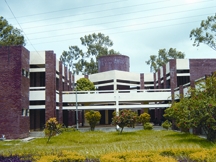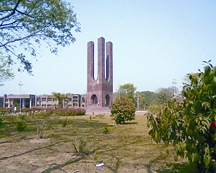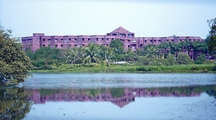Jahangirnagar University: Difference between revisions
(Content Updated.) |
No edit summary |
||
| Line 1: | Line 1: | ||
'''Jahangirnagar University''' | '''Jahangirnagar University''' was the first residential public university of Bangladesh. It is situated about 32 kilometres from Capital Dhaka on Western side of the National Highway near Savar comprising 697.56 acres of land. In the 1960s the Government of Pakistan had a decision to establish a residential university in East Pakistan in the same nature to that of the one built in Islamabad. To ease the student pressure of the University of Dhaka, the Education Department of the Government of East Pakistan framed a plan in June 1964 to establish a residential university near Dhaka. In June 1965 the Executive Board of the National Economic Council approved the plan. | ||
[[Image:JahangirnagarUniversity.jpg|right|thumbnail|300px|TSC, Jahangirnagar University]] | |||
On the basis of this plan a place called Salna in Gazipur district was first earmarked and the foundation stone was laid by Field Marshall Ayub Khan, the then President of Pakistan. Due to some administrative difficulties, this site was abandoned and the present site was chosen, and accordingly 750 acres of land had been allotted for the university and the land was taken away from the Government Dairy Farm, east of the present campus in 1967. In early eighties about 50 acres of the University land from the southern side was taken away by the government for establishing the Bangladesh Public Administrative Training Centre (BPATC). | |||
The university project started its implementation in April 1968 as Jahangirnagar Muslim University and Professor Surat Ali Khan joined as the Project Director on 18 February 1968. On 20 August 1970, an Ordinance was promulgated to start the academic programmes of the university. Professor Mofizuddin Ahmed, the then member of the Central Public Service Commission of Pakistan and formerly a Professor of Chemistry, University of Dhaka, was appointed as the first Vice-Chancellor. He joined as Vice-Chancellor on 24 September 1970. The earlier aim was to establish this university as a science oriented university. For that purpose five faculties, namely, Faculty of Arts and Humanities, Faculty of Social Sciences, Faculty of Biological Sciences, Faculty of Basic Sciences, Faculty of Applied Sciences were earmarked. However, the university was started later with 4 honours departments called Economics, Geography, Statistics and Mathematics and 2 Minor Departments viz English and Bengali. From the second academic session, first female students numbering 13 were enrolled in 1972, The university started with 21 teachers in these departments. Professor Malik Khasru Chowdhury was the first Dean of the Social Science Faculty and also the Head of the Economics Department. Professor AFM Kamaluddin, Professor Obaidullah (Ashkar Ibne Shaikh), and Professor Mirazuddin Mondol were the Head of the Departments of Geography, Statistics and Mathematics respectively. Professor Nurul Islam and Professor Humayun Azad were the Head of the English and Bengali Departments respectively. Professor Mahbubul Huq and Professor MA Raquib were given the charge to do the ground works to open the Chemistry and Physics Departments. A total of 150 male first group students were enrolled in four Honours Departments. The initial class was held on 4 January 1971. Its formal inauguration was delayed until 12 January 1971, when the university was formally launched by Rear Admiral S M Ahsan, the then Governor of East Pakistan and the Chancellor of the University. | |||
A good number students, teachers and employees joined and helped the Liberation Movement of Bangladesh in various ways. The university started in full swing when Professor Syed Ali Ahsan joined as the second Vice-Chancellor in 2 February 1972. On 8th October 1973, The Jahangirnagar University Act was passed in the Jatiya Sangsad with a note: it shall come into force and shall be deemed to have taken effect on the 16th Day of December, 1972. The university is residential; every student has an accommodation in one of the residential halls of the university and used to get a Stipend of Taka 100.00 per month. Being a residential University at present 50% of the top meritorious students in 4 years (from 1st year to 4th year) in Honours levels and 1 year in Masters Level get a Stipend of Taka 500.00 per month (Taka 6000.00) per year. | |||
[[Image:JahangirnagarUniversity2.jpg|left|thumb|300px|Central Shaheed Minar, Jahangirnagar University]] | [[Image:JahangirnagarUniversity2.jpg|left|thumb|300px|Central Shaheed Minar, Jahangirnagar University]] | ||
The university is open to all persons irrespective of religion, caste and creed. The university is an autonomous body managed by an executive body known as the Syndicate. Senate is the highest body of the university. Any change in statutes need ratification from the Senate. The Senate finally passes the annual budget of the university after it is passed by the Finance Committee and the Syndicate, which needs at least once a year to do the same. The Senate also elects a panel of three persons for the appointment of the Vice-Chancellor once in four years. The President of Bangladesh, who is also the Chancellor of the university, appoints a person from that panel. The Vice-Chancellor is a whole time principal executive and academic officer of the university. | The university is open to all persons irrespective of religion, caste and creed. The university is an autonomous body managed by an executive body known as the Syndicate. Senate is the highest body of the university. Any change in statutes need ratification from the Senate. The Senate finally passes the annual budget of the university after it is passed by the Finance Committee and the Syndicate, which needs at least once a year to do the same. The Senate also elects a panel of three persons for the appointment of the Vice-Chancellor once in four years. The President of Bangladesh, who is also the Chancellor of the university, appoints a person from that panel. The Vice-Chancellor is a whole-time principal executive and academic officer of the university. The Registrar is the resident officer of the University. | ||
The Chancellor also appoints the Pro-vice Chancellors and Treasurer of the university. Treasurer is to exercise general supervision over the funds of the university. Academic Council, Board of Advanced Studies, Faculties and Committee of Courses are responsible for the academic matters. The Deans of the different Faculties are elected from their respective Faculties once every two years up to the level of Associate Professor. The chairmanship of the Department rotates among the senior teachers of the respective departments for three years. | The Chancellor also appoints the Pro-vice Chancellors and Treasurer of the university. Treasurer is to exercise general supervision over the funds of the university. Academic Council, Board of Advanced Studies, Faculties and Committee of Courses are responsible for the academic matters. The Deans of the different Faculties are elected from their respective Faculties once every two years up to the level of Associate Professor. The chairmanship of the Department rotates among the senior teachers upto the level of Assistant Professor of the respective departments for three years. | ||
[[Image:JahangirnagarUniversity3.jpg|right|thumb|400px|Pritilata Hall, Jahangirnagar University.]] | |||
The Central Library of the university has a collection of over 120,000 titles. On-line journal browsing and photo copying facilities are also available in the central library of the university. The university has a beautiful Central Mosque, a large Gymnasium, a Swimming Pool, and a Central Cafeteria. The university also has its own Medical Centre. Adequate Bus Services between the campus and Dhaka city are also provided by the university’s own transports. A 71 feet tall Central Shaheed Minar, one of the tallest in the country, in front of the New Arts Building is one of the main attractions of the university. There is an Open-Air Amphitheatre, the very first one in the country, inside the campus is the main venue for the socio-cultural programmes. A Teacher-Students Centre (TSC) is also established for various club activities for teachers and students. The University also runs a School cum College. There are two famous statues, known as Samsaptak, in front of the Central Library and Amar Ekushe in front of the Social Sciences building. | |||
At present January 2023, the university has 38 departments under 6 faculties, 4 institutes, 8 male and 8 female residential halls, a total of 12,938 students, 1024 M.Phil and 1279 PhD students, 721 teachers, 365 officers and 837 Class III and 553 Class IV employees. The names of the faculties are: Faculty of Arts and Humanities, Faculty of Mathematical and Physical Sciences, Faculty of Social Sciences, Faculty of Biological Sciences, Faculty of Business Studies, and Faculty of Law. The names of Institutes are Institute of Business Administration (IBA-JU), Institute of Information Technology), Bangabandhu Comparative Literature and Cultural Institute, and Institute of Remote Sensing and GIS. [Mesbah-us-Saleheen] | |||
[[Category:Education]] | [[Category:Education]] | ||
[[bn:জাহাঙ্গীরনগর বিশ্ববিদ্যালয়]] | [[bn:জাহাঙ্গীরনগর বিশ্ববিদ্যালয়]] | ||
Latest revision as of 15:35, 16 October 2023
Jahangirnagar University was the first residential public university of Bangladesh. It is situated about 32 kilometres from Capital Dhaka on Western side of the National Highway near Savar comprising 697.56 acres of land. In the 1960s the Government of Pakistan had a decision to establish a residential university in East Pakistan in the same nature to that of the one built in Islamabad. To ease the student pressure of the University of Dhaka, the Education Department of the Government of East Pakistan framed a plan in June 1964 to establish a residential university near Dhaka. In June 1965 the Executive Board of the National Economic Council approved the plan.

On the basis of this plan a place called Salna in Gazipur district was first earmarked and the foundation stone was laid by Field Marshall Ayub Khan, the then President of Pakistan. Due to some administrative difficulties, this site was abandoned and the present site was chosen, and accordingly 750 acres of land had been allotted for the university and the land was taken away from the Government Dairy Farm, east of the present campus in 1967. In early eighties about 50 acres of the University land from the southern side was taken away by the government for establishing the Bangladesh Public Administrative Training Centre (BPATC).
The university project started its implementation in April 1968 as Jahangirnagar Muslim University and Professor Surat Ali Khan joined as the Project Director on 18 February 1968. On 20 August 1970, an Ordinance was promulgated to start the academic programmes of the university. Professor Mofizuddin Ahmed, the then member of the Central Public Service Commission of Pakistan and formerly a Professor of Chemistry, University of Dhaka, was appointed as the first Vice-Chancellor. He joined as Vice-Chancellor on 24 September 1970. The earlier aim was to establish this university as a science oriented university. For that purpose five faculties, namely, Faculty of Arts and Humanities, Faculty of Social Sciences, Faculty of Biological Sciences, Faculty of Basic Sciences, Faculty of Applied Sciences were earmarked. However, the university was started later with 4 honours departments called Economics, Geography, Statistics and Mathematics and 2 Minor Departments viz English and Bengali. From the second academic session, first female students numbering 13 were enrolled in 1972, The university started with 21 teachers in these departments. Professor Malik Khasru Chowdhury was the first Dean of the Social Science Faculty and also the Head of the Economics Department. Professor AFM Kamaluddin, Professor Obaidullah (Ashkar Ibne Shaikh), and Professor Mirazuddin Mondol were the Head of the Departments of Geography, Statistics and Mathematics respectively. Professor Nurul Islam and Professor Humayun Azad were the Head of the English and Bengali Departments respectively. Professor Mahbubul Huq and Professor MA Raquib were given the charge to do the ground works to open the Chemistry and Physics Departments. A total of 150 male first group students were enrolled in four Honours Departments. The initial class was held on 4 January 1971. Its formal inauguration was delayed until 12 January 1971, when the university was formally launched by Rear Admiral S M Ahsan, the then Governor of East Pakistan and the Chancellor of the University.
A good number students, teachers and employees joined and helped the Liberation Movement of Bangladesh in various ways. The university started in full swing when Professor Syed Ali Ahsan joined as the second Vice-Chancellor in 2 February 1972. On 8th October 1973, The Jahangirnagar University Act was passed in the Jatiya Sangsad with a note: it shall come into force and shall be deemed to have taken effect on the 16th Day of December, 1972. The university is residential; every student has an accommodation in one of the residential halls of the university and used to get a Stipend of Taka 100.00 per month. Being a residential University at present 50% of the top meritorious students in 4 years (from 1st year to 4th year) in Honours levels and 1 year in Masters Level get a Stipend of Taka 500.00 per month (Taka 6000.00) per year.

The university is open to all persons irrespective of religion, caste and creed. The university is an autonomous body managed by an executive body known as the Syndicate. Senate is the highest body of the university. Any change in statutes need ratification from the Senate. The Senate finally passes the annual budget of the university after it is passed by the Finance Committee and the Syndicate, which needs at least once a year to do the same. The Senate also elects a panel of three persons for the appointment of the Vice-Chancellor once in four years. The President of Bangladesh, who is also the Chancellor of the university, appoints a person from that panel. The Vice-Chancellor is a whole-time principal executive and academic officer of the university. The Registrar is the resident officer of the University.
The Chancellor also appoints the Pro-vice Chancellors and Treasurer of the university. Treasurer is to exercise general supervision over the funds of the university. Academic Council, Board of Advanced Studies, Faculties and Committee of Courses are responsible for the academic matters. The Deans of the different Faculties are elected from their respective Faculties once every two years up to the level of Associate Professor. The chairmanship of the Department rotates among the senior teachers upto the level of Assistant Professor of the respective departments for three years.

The Central Library of the university has a collection of over 120,000 titles. On-line journal browsing and photo copying facilities are also available in the central library of the university. The university has a beautiful Central Mosque, a large Gymnasium, a Swimming Pool, and a Central Cafeteria. The university also has its own Medical Centre. Adequate Bus Services between the campus and Dhaka city are also provided by the university’s own transports. A 71 feet tall Central Shaheed Minar, one of the tallest in the country, in front of the New Arts Building is one of the main attractions of the university. There is an Open-Air Amphitheatre, the very first one in the country, inside the campus is the main venue for the socio-cultural programmes. A Teacher-Students Centre (TSC) is also established for various club activities for teachers and students. The University also runs a School cum College. There are two famous statues, known as Samsaptak, in front of the Central Library and Amar Ekushe in front of the Social Sciences building.
At present January 2023, the university has 38 departments under 6 faculties, 4 institutes, 8 male and 8 female residential halls, a total of 12,938 students, 1024 M.Phil and 1279 PhD students, 721 teachers, 365 officers and 837 Class III and 553 Class IV employees. The names of the faculties are: Faculty of Arts and Humanities, Faculty of Mathematical and Physical Sciences, Faculty of Social Sciences, Faculty of Biological Sciences, Faculty of Business Studies, and Faculty of Law. The names of Institutes are Institute of Business Administration (IBA-JU), Institute of Information Technology), Bangabandhu Comparative Literature and Cultural Institute, and Institute of Remote Sensing and GIS. [Mesbah-us-Saleheen]
